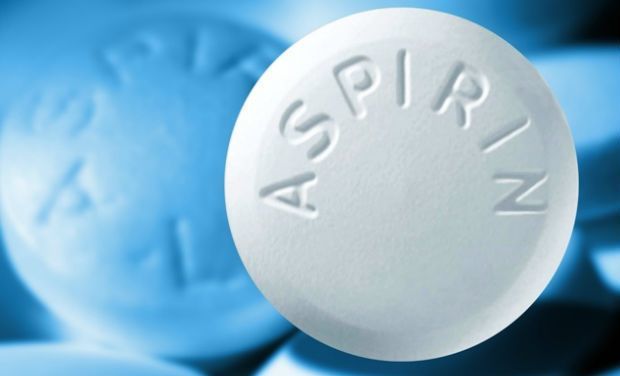Could a trip to CVS, Walgreens or grocery store for an OTC med allow you to exercise? Although this is a small study, if you are heat sensitive, might be worth a try. But like any medication, it makes sense to discuss this with your primary and neuro, especially if you plan to take it regularly. Aspirin is not risk free. - D
Aspirin improves exercise endurance in multiple sclerosis: Pilot findings from a double-blind randomized placebo-controlled crossover trial
ECTRIMS Online Library. Leavitt V. Oct 26, 2017; 200459
Abstract: P804
Type: Poster
Abstract Category: Therapy - symptomatic - 33 Treatment of specific symptoms
Background: Exercise holds many benefits for persons with multiple sclerosis (MS), but exercise is only beneficial if people do it. Many patients are deterred by exercise-induced overheating, exhaustion, and symptom worsening (“Uhthoff's phenomenon”). We conducted a double-blind crossover-design randomized placebo-controlled pilot study of aspirin (ASA) to improve exercise performance and attenuate exercise-related body temperature increase in persons with MS.
Methods: Twelve MS patients participated. At enrollment, 8 of 12 participants reported overheating during exercise, i.e., “heat-sensitive.” All participants completed two maximal aerobic exercise sessions. At each session, participants were administered a standard dose (650 mg) of ASA, or placebo. After one hour, participants performed a progressive ramped exercise test with lower body cycle ergometer. Test was terminated when volitional exhaustion was reached. Paired samples t-tests were conducted to evaluate differences in a) time-to-exhaustion (TTE) between ASA and placebo (primary outcome) and b) change in body temperature from pre- to post-exercise between ASA and placebo (secondary outcome).
Results: Exercise performance (TTE) improved after pre-treatment with aspirin compared to placebo (mean TTE difference=16.4± 23.7 seconds; 95% CI: 1-31 sec); t(11)=2.405, p=0.035 (Cohen's d=1.45). In self-identified heat-sensitive patients, the effect of ASA was larger: t(7)=3.321, p=0.013 (Cohen's d=2.51; 95% CI: 7-44 sec). Exercise-induced body temperature increase did not differ across treatment in the full sample. However, in the heat-sensitive subgroup, there was a 56% attenuation of body temperature increase after exercise with ASA (mean increase= 0.41°F± 0.55) compared to placebo (mean increase= 0.88°F± 0.63); t(7)= -1.494, p=0.178 (Cohen's d=1.13).
Conclusions: Prior exercise work in MS has shown efficacy for cooling treatments, although tested treatments involved obtrusive and/or non-standardizable methods of peripheral cooling such as cold bath pre-cooling and vacuum hand-cooling chambers. ASA, selected for its antipyretic effect, is convenient, inexpensive, readily accessible, and unobtrusive. This pilot study suggests that aspirin may represent an easy, economical treatment to enable people with MS to access the many benefits of exercise.

Aspirin improves exercise endurance in multiple sclerosis: Pilot findings from a double-blind randomized placebo-controlled crossover trial
ECTRIMS Online Library. Leavitt V. Oct 26, 2017; 200459
Abstract: P804
Type: Poster
Abstract Category: Therapy - symptomatic - 33 Treatment of specific symptoms
Background: Exercise holds many benefits for persons with multiple sclerosis (MS), but exercise is only beneficial if people do it. Many patients are deterred by exercise-induced overheating, exhaustion, and symptom worsening (“Uhthoff's phenomenon”). We conducted a double-blind crossover-design randomized placebo-controlled pilot study of aspirin (ASA) to improve exercise performance and attenuate exercise-related body temperature increase in persons with MS.
Methods: Twelve MS patients participated. At enrollment, 8 of 12 participants reported overheating during exercise, i.e., “heat-sensitive.” All participants completed two maximal aerobic exercise sessions. At each session, participants were administered a standard dose (650 mg) of ASA, or placebo. After one hour, participants performed a progressive ramped exercise test with lower body cycle ergometer. Test was terminated when volitional exhaustion was reached. Paired samples t-tests were conducted to evaluate differences in a) time-to-exhaustion (TTE) between ASA and placebo (primary outcome) and b) change in body temperature from pre- to post-exercise between ASA and placebo (secondary outcome).
Results: Exercise performance (TTE) improved after pre-treatment with aspirin compared to placebo (mean TTE difference=16.4± 23.7 seconds; 95% CI: 1-31 sec); t(11)=2.405, p=0.035 (Cohen's d=1.45). In self-identified heat-sensitive patients, the effect of ASA was larger: t(7)=3.321, p=0.013 (Cohen's d=2.51; 95% CI: 7-44 sec). Exercise-induced body temperature increase did not differ across treatment in the full sample. However, in the heat-sensitive subgroup, there was a 56% attenuation of body temperature increase after exercise with ASA (mean increase= 0.41°F± 0.55) compared to placebo (mean increase= 0.88°F± 0.63); t(7)= -1.494, p=0.178 (Cohen's d=1.13).
Conclusions: Prior exercise work in MS has shown efficacy for cooling treatments, although tested treatments involved obtrusive and/or non-standardizable methods of peripheral cooling such as cold bath pre-cooling and vacuum hand-cooling chambers. ASA, selected for its antipyretic effect, is convenient, inexpensive, readily accessible, and unobtrusive. This pilot study suggests that aspirin may represent an easy, economical treatment to enable people with MS to access the many benefits of exercise.

Comment